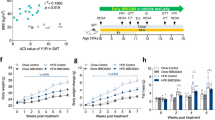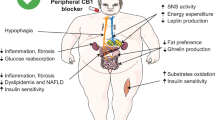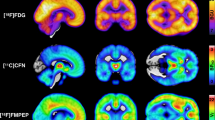Abstract
Objective:
To investigate whether drugs targeting peripheral cannabinoid-1 (CB1) receptor ameliorate adiposity comparable to central CB1-receptor antagonist or not.
Measurements:
Receptor binding assay and functional assay in vitro. Pharmacokinetic parameters in mice, brain uptake clearance of compounds in rats and antagonism on the CB1-agonist-induced hypothermia in mice. Diet consumption, body weight changes, hepatic gene expression of sterol-regulatory element-binding protein-1 (SREBP-1) and plasma/tissue concentrations of compounds in HF diet-induced obese (HF-DIO) mice after acute and chronic treatment.
Results:
Compound-1, an SR141716A derivative, is a peripheral CB1-receptor-selective antagonist that is 10 times less potent than SR141716A in in vitro evaluations. Although the plasma concentrations of Compound-1 are five times higher than those of SR141716A, its potency is still 10 times lower than that of SR141716A in reducing the consumption of normal or HF diet by mice. Through evaluations of brain uptake and the effect on CB1-agonist-induced hypothermia, it was verified that the blood–brain barrier (BBB) penetration of Compound-1 is much lower than that of SR141716A. In HF-DIO mice, chronic treatment by Compound-1 showed dose-dependent antiobesity activities, while its brain distribution was very low as compared with that of SR141716A. Compound-1’s effective doses for antiobesity activity were just over 30 mg kg−1. However, Compound-1 completely suppressed the elevated hepatic SREBP-1 expression even at 10 mg kg−1.
Conclusion:
These results suggest that (1) central CB1 receptors mediate anorectic response of CB1-receptor antagonists and (2) peripheral modulations, including SREBP-1 expression, are not major mechanisms in the antiobesity effects of CB1-receptor antagonists.
This is a preview of subscription content, access via your institution
Access options
Subscribe to this journal
Receive 12 print issues and online access
$259.00 per year
only $21.58 per issue
Buy this article
- Purchase on Springer Link
- Instant access to full article PDF
Prices may be subject to local taxes which are calculated during checkout







Similar content being viewed by others
Accession codes
References
Cota D, Marsicano G, Tschop M, Grubler Y, Flachskamm C, Schubert M et al. The endogenous cannabinoid system affects energy balance via central orexigenic drive and peripheral lipogenesis. J Clin Invest 2003; 112: 423–431.
Kirkham TC, Williams CM, Fezza F, Di Marzo V . Endocannabinoid levels in rat limbic forebrain and hypothalamus in relation to fasting, feeding and satiation: stimulation of eating by 2-arachidonoyl glycerol. Br J Pharmacol 2002; 136: 550–557.
Coutts AA, Izzo AA . The gastrointestinal pharmacology of cannabinoids: an update. Curr Opin Pharmacol 2004; 4: 572–579.
Osei-Hyiaman D, DePetrillo M, Pacher P, Liu J, Radaeva S, Batkai S et al. Endocannabinoid activation at hepatic CB1 receptors stimulates fatty acid synthesis and contributes to diet-induced obesity. J Clin Invest 2005; 115: 1298–1305.
Bluher M, Engeli S, Kloting N, Berndt J, Fasshauer M, Batkai S et al. Dysregulation of the peripheral and adipose tissue endocannabinoid system in human abdominal obesity. Diabetes 2006; 55: 3053–3060.
Jones D . End of the line for cannabinoid receptor 1 as an antiobesity target? Nat Rev Drug Discov 2008; 7: 961–962.
Gary-Bobo M, Elachouri G, Scatton B, Le Fur G, Oury-Donat F, Bensaid M . The cannabinoid CB1 receptor antagonist rimonabant (SR141716) inhibits cell proliferation and increases markers of adipocyte maturation in cultured mouse 3T3 F442A preadipocytes. Mol Pharmacol 2006; 69: 471–478.
Matias I, Gonthier MP, Orlando P, Martiadis V, De Petrocellis L, Cervino C et al. Regulation, function, and dysregulation of endocannabinoids in models of adipose and beta-pancreatic cells and in obesity and hyperglycemia. J Clin Endocrinol Metab 2006; 91: 3171–3180.
Gomez R, Navarro M, Ferrer B, Trigo JM, Bilbao A, Del Arco I et al. A peripheral mechanism for CB1 cannabinoid receptor-dependent modulation of feeding. J Neurosci 2002; 22: 9612–9617.
Pavon FJ, Bilbao A, Hernandez-Folgado L, Cippitelli A, Jagerovic N, Abellan G et al. Antiobesity effects of the novel in vivo neutral cannabinoid receptor antagonist 5-(4-chlorophenyl)-1-(2,4-dichlorophenyl)-3-hexyl-1H-1,2,4-triazole—LH 21. Neuropharmacology 2006; 51: 358–366.
Pavon FJ, Serrano A, Perez-Valero V, Jagerovic N, Hernandez-Folgado L, Bermudez-Silva FJ et al. Central versus peripheral antagonism of cannabinoid CB1 receptor in obesity: effects of LH-21, a peripherally acting neutral cannabinoid receptor antagonist, in Zucker rats. J Neuroendocrinol 2008; 20: 116–123.
Chen RZ, Frassetto A, Lao JZ, Huang RR, Xiao JC, Clements MJ et al. Pharmacological evaluation of LH-21, a newly discovered molecule that binds to cannabinoid CB1 receptor. Eur J Pharmacol 2008; 584: 338–342.
Horvath TL . The unfolding cannabinoid story on energy homeostasis: central or peripheral site of action? Int J Obes (Lond) 2006; 30: S30–S32.
Ravinet Trillou C, Arnone M, Delgorge C, Gonalons N, Keane P, Maffrand JP et al. Antiobesity effect of SR141716, a CB1 receptor antagonist, in diet-induced obese mice. Am J Physiol Regul Integr Comp Physiol 2003; 284: R345–R353.
Christensen R, Kristensen PK, Bartels EM, Bliddal H, Astrup A . Efficacy and safety of the weight-loss drug rimonabant: a meta-analysis of randomised trials. Lancet 2007; 370: 1706–1713.
Janero DR, Makriyannis A . Cannabinoid receptor antagonists: pharmacological opportunities, clinical experience, and translational prognosis. Expert Opin Emerg Drugs 2009; 14: 43–65.
Witkin JM, Tzavara ET, Davis RJ, Li X, Nomikos GG . A therapeutic role for cannabinoid CB1 receptor antagonists in major depressive disorders. Trends Pharmacol Sci 2005; 26: 609–617.
Devane WA, Dysarz 3rd FA, Johnson MR, Melvin LS, Howlett AC . Determination and characterization of a cannabinoid receptor in rat brain. Mol Pharmacol 1988; 34: 605–613.
Rinaldi-Carmona M, Barth F, Heaulme M, Shire D, Calandra B, Congy C et al. SR141716A, a potent and selective antagonist of the brain cannabinoid receptor. FEBS Lett 1994; 350: 240–244.
Kim KP, Ahn SH, Sung JH, Koo TS, Byun MJ, Kim DD et al. Application of a sample pooling method for the accelerated assessment of the rate of uptake of drugs by the brain in rats. J Pharm Pharmacol 2006; 58: 837–846.
Wiley JL, Burston JJ, Leggett DC, Alekseeva OO, Razdan RK, Mahadevan A et al. CB1 cannabinoid receptor-mediated modulation of food intake in mice. Br J Pharmacol 2005; 145: 293–300.
Takahashi Y, Kushiro M, Shinohara K, Ide T . Dietary conjugated linoleic acid reduces body fat mass and affects gene expression of proteins regulating energy metabolism in mice. Comp Biochem Physiol B Biochem Mol Biol 2002; 133: 395–404.
McMahon LR, Koek W . Differences in the relative potency of SR 141716A and AM 251 as antagonists of various in vivo effects of cannabinoid agonists in C57BL/6J mice. Eur J Pharmacol 2007; 569: 70–76.
Jolliet P, Nion S, Allain-Veyrac G, Tilloy-Fenart L, Vanuxeem D, Berezowski V et al. Evidence of lowest brain penetration of an antiemetic drug, metopimazine, compared to domperidone, metoclopramide and chlorpromazine, using an in vitro model of the blood-brain barrier. Pharmacol Res 2007; 56: 11–17.
Liu X, Smith BJ, Chen C, Callegari E, Becker SL, Chen X et al. Use of a physiologically based pharmacokinetic model to study the time to reach brain equilibrium: an experimental analysis of the role of blood–brain barrier permeability, plasma protein binding, and brain tissue binding. J Pharmacol Exp Ther 2005; 313: 1254–1262.
Boulant JA . Hypothalamic mechanisms in thermoregulation. Fed Proc 1981; 40: 2843–2850.
Fitton AG, Pertwee RG . Changes in body temperature and oxygen consumption rate of conscious mice produced by intrahypothalamic and intracerebroventricular injections of delta 9-tetrahydrocannabinol. Br J Pharmacol 1982; 75: 409–414.
Rawls SM, Cabassa J, Geller EB, Adler MW . CB1 receptors in the preoptic anterior hypothalamus regulate WIN 55212-2 [(4,5-dihydro-2-methyl-4(4-morpholinylmethyl)-1-(1-naphthalenyl-carbonyl)- 6H-pyrrolo[3,2,1ij]quinolin-6-one]-induced hypothermia. J Pharmacol Exp Ther 2002; 301: 963–968.
Artmann A, Petersen G, Hellgren LI, Boberg J, Skonberg C, Nellemann C et al. Influence of dietary fatty acids on endocannabinoid and N-acylethanolamine levels in rat brain, liver and small intestine. Biochim Biophys Acta 2008; 1781: 200–212.
Jbilo O, Ravinet-Trillou C, Arnone M, Buisson I, Bribes E, Peleraux A et al. The CB1 receptor antagonist rimonabant reverses the diet-induced obesity phenotype through the regulation of lipolysis and energy balance. FASEB J 2005; 19: 1567–1569.
Bensaid M, Gary-Bobo M, Esclangon A, Maffrand JP, Le Fur G, Oury-Donat F et al. The cannabinoid CB1 receptor antagonist SR141716 increases Acrp30 mRNA expression in adipose tissue of obese fa/fa rats and in cultured adipocyte cells. Mol Pharmacol 2003; 63: 908–914.
Acknowledgements
We are grateful to Dr Chung SJ (Seoul National University) for technical advice on brain uptake measurements. This work was supported by the post BK 21 program and SH pharmaceutical company.
Author information
Authors and Affiliations
Corresponding author
Rights and permissions
About this article
Cite this article
Son, MH., Kim, H., Chae, Y. et al. Peripherally acting CB1-receptor antagonist: the relative importance of central and peripheral CB1 receptors in adiposity control. Int J Obes 34, 547–556 (2010). https://doi.org/10.1038/ijo.2009.253
Received:
Revised:
Accepted:
Published:
Issue Date:
DOI: https://doi.org/10.1038/ijo.2009.253
Keywords
This article is cited by
-
A novel chemical inhibitor suppresses breast cancer cell growth and metastasis through inhibiting HPIP oncoprotein
Cell Death Discovery (2021)
-
Anti-obesity therapy with peripheral CB1 blockers: from promise to safe(?) practice
International Journal of Obesity (2020)
-
The analgesic effect of refeeding on acute and chronic inflammatory pain
Scientific Reports (2019)
-
Control of excessive neural circuit excitability and prevention of epileptic seizures by endocannabinoid signaling
Cellular and Molecular Life Sciences (2018)
-
Pro-inflammatory obesity in aged cannabinoid-2 receptor-deficient mice
International Journal of Obesity (2016)



